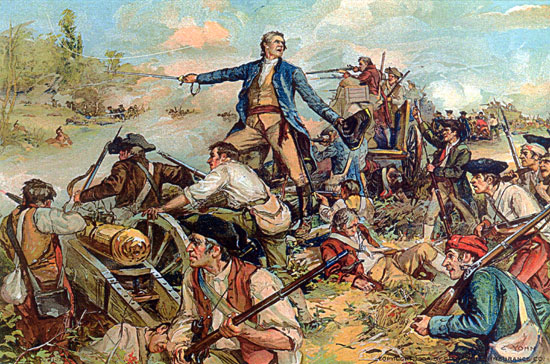| |

IN the year 1754 a comprehensive plan was formulated by the English to drive the French from America. The first move in this general
plan, that of General Braddock, Commander-in-Chief, against Fort Duquesne,
was a sanguinary failure, even as mitigated by the bravery and skill of the then
young Colonel Washington. Braddock's defeat so discouraged General Shirley that his expedition against Fort Niagara
was abandoned. In pursuance of the next move, late in the summer of 1755, Major-General Johnson gathered at Albany
from the vicinity Colonies the force which he was to lead against Crown Point and Canada. Early in August he sent
his advance up the Hudson under General Lyman, who began the construction of Fort Lyman, afterward named Fort
Edward. Later in the month General Johnson and his gathered force reached Lac St. Sacrement, which name he at
once changed to Lake George, in honor of his king.
General Johnson's force consisted of about 3,000 Colonists and some 300 Indians, the latter under King Hendrick
the famous Mohawk satchem, and friend of Johnson. Among his officers, some of them afterward becoming notable, were
General Phineas Lyman, Colonels Ephraim Williams, Timothy Ruggles and Moses Titcomb; Lieutenant-Colonels
Nathan Whiting and Seth Pomeroy; Captains Philip Schuyler and Israel Putnam.
In the meantime. Baron Dieskau, a
distinguished German officer, commanding the French forces in Canada, arrived
at Crown Point with 3,000 men, quite one-third veteran regulars from French battlefields.
Dieskau was brave, experienced and enterprising, and exemplifying his motto,
"Boldness Wins," not only proceeded to fortify Ticonderoga, but, believing that the
new Fort Lyman was incomplete and feebly garrisoned, decided to march against it.
With a flying corps of about 300 regulars, 800 Canadians and as many Indians, he moved
up Lake Champlain and South
Bay. Reaching the Hudson
near the present site of
Glens Falls on September 7, his
Indians hesitated, or refused,
to farther proceed against
Fort Lyman and its "big
guns." Learning that General
Johnson was already at Lake
George, and with contempt for
his "provincial farmers." Dieskau promptly decided to make
a sudden attack upon Johnson's camp the next morning.
Johnson, learning of the
French invasion and proposed
attack on Fort Lyman, sent out
a relieving force on the morning of September 8, of 1,000
Colonials and 200 Indians,
under Colonel Williams and old
King Hendrick. This force fell
into ambush, planned by Dieskau, a few miles from Lake
George, resulting in severe
loss, the killed inducing Colonel
Williams and King Hendrick. This engagement has passed into history and story
as "The Bloody Morning Scout." Lieutenant-Colonel Whiting conducted a hurried
retreat, but with the aid of 300 men sent to his support from Johnson's camp,
gave some check to Dieskau's furious pursuit.

Lake George Battle Monument |
The noise of this engagement gave warning to Johnson's camp, where breastworks
were hastily improvised from logs, fallen trees, wagons, etc., and such cannons as they
had were placed in advantageous position under Captain Eyre. Dieskau followed closely
upon the heels of the retreating provincials, with the intention of entering Johnson's
camp, which he promptly and fiercely attacked, but was checked by the artillery and by
the firm stand of the Colonists. The battle raged with varying promise during the afternoon.
At last the Colonials and their Indian allies, confident of victory, charged from
their breastworks against the French and forced them to a precipitate retreat, leaving
most of their regulars dead on the field. General Johnson was wounded early in the action
and General Lyman, the Yale tutor and lawyer, commanded with much spirit and bravery.
Baron Dieskau was three times severely wounded, and left on the field a prisoner.
Chevalier Montreuil commanded after Dieskau was disabled,
The illustration is from the painting by Mr. Yohn, owned by the
Glens Falls insurance Co., and represents the spirited inception of the final victorious
charge of the provincials.
Some 300 Canadians and Indians fell back to the field of "The Bloody Morning
Scout" to scalp and plunder the dead. While resting with their plunder on the margin
of a stagnant forest pool (seven miles from Glens Falls), they were surprised by some
200 men sent out from Fort, Lyman under Captain Maginnes, resulting in the killing of
most of this contingent. The bodies of the slain were thrown into the pool and the
water was so tinged with blood as to give this pool the name of "Bloody Pond," by which
name it is still known to residents and tourists.
Captain Maginnes died from wounds received in this engagement. These three
engagements – morning, afternoon, and night - comprise the Battle of Lake George.
General Johnson estimated the French loss at more than 500, their, dead including La
Gardeur de St. Pierre, who defeated Washington on the Ohio the year before. The
Colonials lost over 260, not counting Indian allies, and their dead included Colonel
Williams, King Hendrick, Colonel Titcomb, Major Ashley, Captains Maginnes, Keyes,
Porter," lngersoll and twelve other officers.
This sketch is but mere mention of this "day of battles," memorable as the first considerable
success against the French in America, as the then most important battle fought
on New York soil, and as the first encounter of the yeomanry of the New World with
the disciplined troops and experienced officers of the Old. It was the test which developed
that .confidence, which led the Colonists to dare the great struggle of the
Revolution.
On September 8, 1903, a monument, erected by the Society of the Colonial Wars in
the State of New York, was unveiled and dedicated with elaborate and appropriate public ceremonies. The vicinity of this monument, the battlefield itself, is now a State
Park. secured by the influence of the New York State Historical Society.

Bloody Pond, About Seven Miles North of Glens Falls
Back to the Stories of the French & Indian and Revolutionary Wars. |


